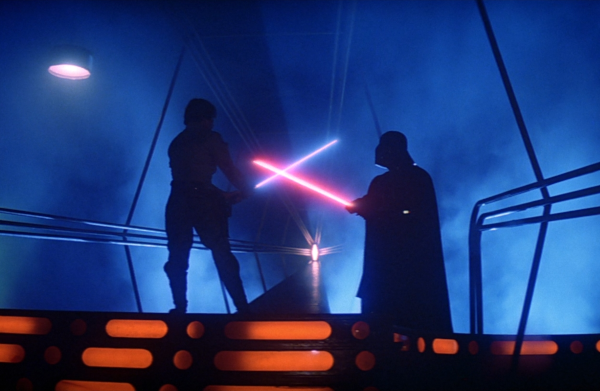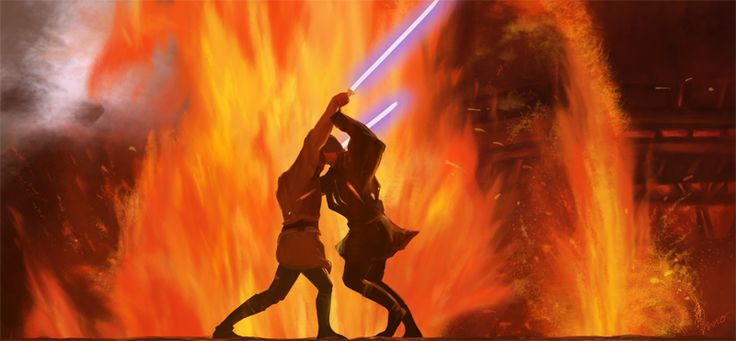Combat Writing
Introduction
This course is intended to serve as a guide for writing fight scenes. The intention is that the content in this course is applicable across all combat writing, whether this is in your own single-player stories, the ACC, or even writing outside of the club.
Blow-by-blows are boring
These days we’re saturated by visual media. In visual media, a blow-by-blow fight scene can work. It can be fun to watch Bruce Lee dispatch 30 bad guys in progressively cooler ways. But in the written word, this just isn't very interesting.

As a writer, we can very easily connect character motivation with character action and give a sense of progress through a scene. We can show how the characters feel during the fight and what they are trying to achieve, and these are far more important than the mechanics of what arm moved where to block which kick. The reader doesn't need to imagine the fight in exactly the way you do. But they need to feel the emotion, tension and stakes that place the fight in the story.
Paul readied himself in a defensive stance, slightly crouched, both hands high by the side of his head, right foot back. Steve darted forwards with his left foot, closing the distance and throwing a quick punch with his left hand down the middle, towards Paul's nose. Paul moved his right foot off-line, tilting his body to avoid the punch, then loaded up his hips and returned with a right hand punch to the side of Steve's head. The old man was faster, and pulled his left hand back to block.
I think this gives you a really solid idea of what, exactly, happened.
Paul was ready. He had trained years for this moment. Steve jabbed with his left. Just like in training. Paul dodged and returned with a thunderous right. Blocked. How was the old man so fast?
This is less detailed. But much more dramatic. We see a connection between what's in Paul's head and what's happening in the fight. The details of his stance aren’t relevant. Only that he’s ready, and prepared. There’s a connection between his training and the action. ‘Blocked.’ is a one-word sentence that describes the action just fine.
Make the Motivations and Stakes Clear
Motivation and stakes are absolutely critical for an exciting, dramatic fight scene and these work best if they're something personal to the character. Sure, if they lose, they die. OK, sure, dying is bad, but that's true of every story with a war in it. We've seen that all before.
Star Wars is a great example of mixing things up. Recall the final fight between Luke and Vader, the protagonist against the main villain. Luke and Vader have a familial relationship that affects the motivation of both of them. Luke wants to turn Vader back to the light side. Vader wants the opposite, and wants Luke as an apprentice but also can't show this in front of the Emperor, who wants Luke to take his father's place. When he refuses, we see Vader's true loyalties shine through as he throws the Emperor down the reactor shaft.
The quality of the choreography is questionable. But it's the multiple conflicting emotions that each character has that make the fight scene stand out.
If Character A is chasing Character B, the scene is fine enough. If we know the stakes of Character B escaping, the scene is much better. If we care about Character A and Character B, and have a preferred outcome to the chase, now the scene matters.
This is as true in the ACC as it is in any other area of writing. Although the ACC will obviously have a higher proportion of fighting happening than the average story, it is motivations, stakes, and connecting them with action that will elevate your scores.
Develop Character and Plot
The fight scene should always move the story forward. If, after the fight scene, the situation is exactly the same as it was before, then that fight scene has not contributed anything to the narrative. Every fight should contribute something to the wider plot, otherwise, it’s just gratuitous violence, which can be fun on film but very rarely fun to read.
Fight scenes are often the biggest challenges our characters face. Since we're in our character's head a lot of the time, we can use that to explore who they really are. Consider some of these questions
- Why do they make the choices that they make in the fight?
- How does this choice reflect their inner character?
- How does each action impact their goals?
- Is this conflict getting the character closer or further away from their goals? How?
- What do they stand to win? What will they lose?
- What type of fighter is the character? What are their physical or mental abilities?
Think about what impact you want the fight to have on the character. Do you want the fight to inflict long-lasting post-traumatic stress disorder, or a glorious victory that raises the character's morale? If the character feels nothing after the fight, then the reader likely feels nothing, and storytelling is about making people feel things.
Keep the Pace High
Words are slow. Fights are fast. This creates a problem. Use fewer of them.

In a fight scene, try to use as few words as possible. This isn't the time to show off your purple prose and metaphoric language. Short sentences are great for that. They're punchy and sharp. Easy to digest. You can even go a step further and use sentence fragments, showing clear, complete thoughts are impossible. See the ‘Blocked.’ example from earlier.
But while 'write short sentences' is not bad advice, consider the following:
Dumbledore brandished his wand in one long, fluid movement – the snake, which had been an instant from sinking its fangs into him, flew high into the air and vanished in a wisp of dark smoke; the water in the pool rose up and covered Voldemort like a cocoon of broken glass.’ - JK Rowling - Harry Potter and the Order of the Phoenix.
This sentence is a massive 52 words. But it’s so fast-paced that it is actually quicker to read out loud (10-15 seconds) than it takes to happen in the movie (20 seconds). The key here is that although the sentence is long, the action beats are short. Also, the sentence has a lot of punctuation and is essentially lots of short sentences, but writing it without a full stop makes the action feel more flowing, and the semicolon is timed at a dramatic pause in the action. A more detailed breakdown of this particular concept can be found in Professor Zentru’la’s Autumn 2022 lecture
To maintain pacing, it's important to put the background work in. We need to know what the characters look like, what weapons they have, and where the fight is taking place. All that is important. But the fight scene itself is not the place for it. Before the fight starts, we need to already know what the characters and environment look like.
Ensure Progress is Constant
Similar to how the scene itself should progress the plot, every paragraph should progress the fight in some way. You could write a fantastic fast-paced lightsaber duel between two characters we care about, with clearly defined stakes, but if they’re slashing at each other with lightsabers, and two pages later, they’re still slashing at each other with lightsabers, nothing has actually happened. There needs to be a sense of cause and effect, each action makes something else happen, which makes things progress towards a conclusion.
The cliffs were very close behind him now. Inigo continued to retreat; the man in black continued advancing. Then Inigo countered with the Thibault. And the man in black blocked it. William Goldman - The Princess Bride
This quote shows a lot of things. We're progressing (towards a cliff). Inigo can retreat, but at some point he has to stop. The cliff has already been established so we don't need to describe it here. We don't need complex details about martial arts, we're just told he countered with 'the Thibault' (which makes about as much sense as saying he attacked with the Jackie Chan). But it doesn't matter. We feel the drama, the stakes, and the progression. Progress can be made in lots of different ways. Consider the following:
- They’re in a new environment now.
- One character has lost his weapon.
- One character has a minor injury.
- The reinforcements are closing in and time is running out to finish the fight.
- The bad guy is stalling for time so his boss can escape, and he's getting further away
- Some taunting has caused a character’s approach to change.
- Someone is dead.
A lot of ACC posts can feel kind of pointless, like a lot of fighting has been described, but not a lot has actually happened. Always make sure progress is being made towards something. It doesn’t matter what.
Use powerful, specific verbs
Try to use powerful verbs where possible, rather than adverbs, which often support weak prose and slow the pacing. They usually accompany a boring verb to make it more interesting. A more specific verb generally does a better job. Consider the following, describing a basic punch:
Bob punched Jim hard and accurately in the face, causing him to stumble backwards clumsily.
Vs
Bob smashed Jim in the face. He stumbled backwards and crashed into the wall. His helmet was dented.
‘Smash’ is stronger than ‘punched hard’. We’re also shown (rather than told) the power and accuracy by the denting of the helmet. ‘Clumsily’ is a pointless word (how else does one stumble?). In the second version, we see how he stumbles through action (hitting a wall). There’s more of a sense of cause and effect.
Caveat: Don’t just go on a massive hunt to remove all adverbs at all costs. ‘He stumbled clumsily’ is still better than ‘He stumbled with clumsiness’ which technically removes an adverb.
Focus on one Character
Sweeping wide-angle shots of a huge battle scene works great in a movie, but are very difficult to translate into the written word. In writing, we need to stay closer to our main character. They might be one part of giant melee, but they are the part we’re interested in. Try not to jump back and forth between characters and try to describe an entire battle.
If you have multiple characters, a short update every now and then is all you need.
John rushed off to the side toward the guys with machine guns, and Mary ducked behind cover and threw a grenade. - Brandon Sanderson - Lecture 11: Three Rules for Fight Scenes.
Now we can get back to what our main character is doing. Maybe give an update every now and then in a quick sentence, but we focus on our main character. In Harry Potter and the Order of the Phoenix, we have about 10 good guys and 10 bad guys fighting each other, it's chaotic, it's a mess, but we focus on Harry. We do get quick updates about what the others are doing, we see Sirius 'raining down spells', and on the next page 'duelling a death eater'. It never takes many words, but we always know what Sirius is doing up until his death.
Conclusion
Fight scenes are complicated, hard to get right and easy to get wrong. Focus on character motivation, and make sure there’s progress through the scene. Keep the pacing high, avoid unnecessary description, and most importantly, avoid a blow-by-blow commentary of what happened.
Please log in to take this course's exam